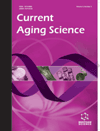- Home
- A-Z Publications
- Current Aging Science
- Previous Issues
- Volume 2, Issue 1, 2009
Current Aging Science - Volume 2, Issue 1, 2009
Volume 2, Issue 1, 2009
-
-
Does Aging Stop?
More LessAuthors: Parvin Shahrestani, Laurence D. Mueller and Michael R. RoseHuman mortality data show stabilization in mortality rates at very late ages. But human mortality data are difficult to interpret because they are affected by changing medical practices and other historically variable causes of death. However, in the 1990s, data from a variety of labs showed that the mortality rates of medflies, fruit flies, wasps, yeasts, and nematodes also stabilize at very late ages. These reproducible “mortal Read More
-
-
-
Mitochondria, Cellular Stress Resistance, Somatic Cell Depletion and Lifespan
More LessAuthors: Ellen L. Robb, Melissa M. Page and Jeffrey A. StuartThe causes of aging and determinants of maximum lifespan in animal species are multifaceted and complex. However, a wealth of experimental data suggests that mitochondria are involved both in the aging process and in regulating lifespan. Here we outline a somatic cell depletion (SCD) model to account for correlations between: (1) mitochondrial reactive oxygen species and lifespan; (2) mitochondrial antioxidant enzym Read More
-
-
-
The Association of Very High Hair Manganese Accumulation and High Oxidative Stress in Mongolian People
More LessOxidative stress induces several diseases and early aging. Previously, we reported that Mongolians are exposed in high oxidative stress, which may cause their early aging. In this study, to know the reason of high oxidative stress, we measured hair metals. This investigation was performed in Murun city, in the northern area of this country, and 469 healthy subjects, ranging from 10 to 82 years of age, were randomly enrolled. Read More
-
-
-
Visuospatial Memory in Healthy Elderly, AD and MCI: A Review
More LessIn the literature it is commonly reported that several spatial abilities decline with normal aging, even though such a decline is not uniform. So far, it is not yet clear which spatial components present a normal age-related decline, which ones are preserved and at what point the deficit is so severe to represent an index of mild cognitive impairment (MCI) or a symptom of potential degenerative progression as in the early-stage Alzhe Read More
-
-
-
Greater Specificity of Sensorimotor Learning in the Elderly When Acquiring an Interceptive Task
More LessAuthors: Luis A. Teixeira and Elke dos Santos LimaIn this investigation we assessed the extent to which young and elderly individuals become dependent on the specific visual situation present during practice of an interceptive task. Young and elderly participants practiced extensively a task of intercepting a virtually moving target under full vision or visual occlusion of the last 600 ms of target displacement. Before and after practice they were assessed in four visual conditions vary Read More
-
-
-
Effect of Gender on Main Clinical Chemistry Parameters in Aged Rats
More LessAuthors: Refik Kayali, Seval Aydin and Ufuk CakatayIntroduction: Clinical laboratory data are crucially important for the diagnosis, prognosis and therapy of agingrelated diseases. The age-dependent changes in the findings of routine clinical-chemistry analyses may influence the evaluation of health status of the elderly people. Serum endogenous antioxidant levels and lipid profiles are considered to be related to the progress of age-related diseases. Analyses of these r Read More
-
-
-
The Use of Sensory Nerve Stimulation and Compression Bandaging to Improve Sensory Nerve Function and Healing of Chronic Venous Leg Ulcers
More LessAuthors: Rajna Ogrin, Peteris Darzins and Zeinab KhalilLow frequency transcutaneous sensory nerve stimulation (LF-SNS) [International Patent PCT/AU2004/001079:“nerve function and tissue healing” (Khalil, Z.)] improves sensory nerve function and accelerates wound healing of older animals. Intervention: Double blind, placebo controlled randomised trial of LF-SNS for 5 minutes, twice daily for up to 12 weeks, on healing of chronic venous leg ulcers in older people. Four lay Read More
-
Volumes & issues
Most Read This Month
Article
content/journals/cas
Journal
10
5
false
en

Most Cited Most Cited RSS feed
-
-
Polyphenols and Aging
Authors: Brannon L. Queen and Trygve O. Tollefsbol
-
- More Less

